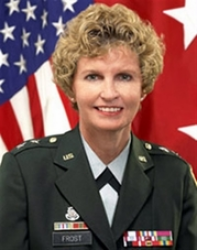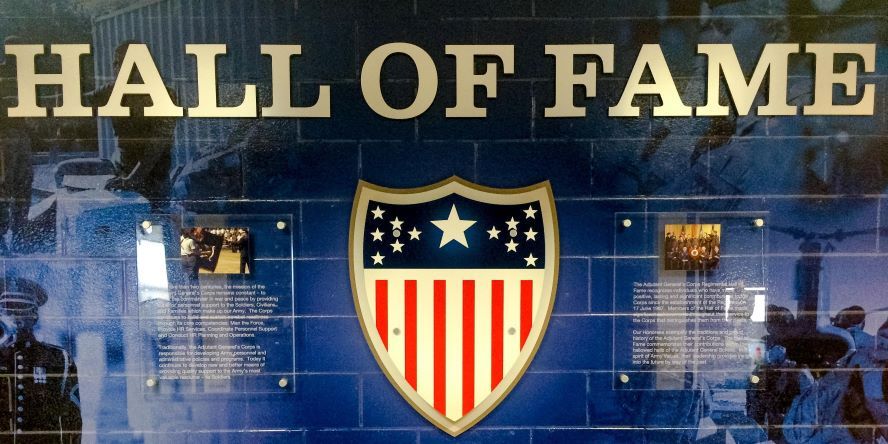AG Corps HOF Class of 2011

MG (Ret) Kathryn G. Frost’s career included several prominent assignments. In the 1980s, she was a social aide to the White House for both President Ronald Reagan and President George Bush. During the 1991 Gulf War, MG (Ret) Frost was on the legislative liaison staff of General Colin Powell, Chairman of the Joint Chiefs of Staff. She also served as Commander of the Eastern Sector of the United States Military Entrance Processing Command. After serving two years as the Deputy Commander of the Army and Air Force Exchange Service, which operates the post and base exchanges on military installations nationally and overseas, her career included a four-year assignment as The Adjutant General (TAG) of the U.S. Army. MG (Ret) Frost was diagnosed with breast cancer a month before she assumed command of AAFES in August 2002. Despite having had a mastectomy, she reported to duty on time. Under her command, AAFES was ranked third of 20 retail stores for consumer electronics by Consumer Reports and was named textile retailer of the year for 2005. At the time of her retirement from the Army in 2005 after 31 years of service, MG (Ret) Frost was the highest-ranking woman in the U.S. Army. On 18 August 2006, MG (Ret) Frost passed away in Latta, South Carolina, where she grew up.

MG (Ret) William G. O’Leksy served first as the Adjutant General, then as the G1 of the 1st Infantry Division in Vietnam. He excelled in both of these positions under intense circumstances, both in theater and on the American home front. His follow-on assignment after serving in Vietnam was at the Manpower Control Division, Office of the Chief of Staff of the Army. While on this assignment he spearheaded a reduction in HQDA staff agency personnel authorizations by linking authorizations to agency missions and functions, a first in the headquarters and in achieving the VCSA’s objectives. It is clear that MG (Ret) O’Leksy understood the importance of technology for the success of the AG Corps and the Army. His leadership and innovation in this arena laid a solid foundation for future HR systems architecture, paving the way for the AG Corps and transforming the way the Army does its HR business. Though he is highly noted for his technical savvy, he was also a Soldier’s Soldier. MG (Ret) O’Leksy cared deeply for the Army’s greatest asset, its men and women. His keen insight into the mechanisms that sustained our efforts within the human resources field established a firm system for the AG Corps to do what it does best, support Commanders in the field by accurately accounting for and supporting their troops, and more importantly taking care of Soldiers and their Families.

BG (Ret) Robert “Lex” Dilworth served the U.S. Army with a vision for the future, while maintaining a solid grasp on the present. The legacy he leaves behind includes the model for the Army Civilian Career Intern Program and the Army Transition Management Program, recognized today as the Army Career and Alumni Program (ACAP). Throughout his career, BG (Ret) Dilworth created numerous systems that were recognized and adopted as the standard way to conduct business Army-wide. As The Adjutant General (TAG) of the Army, BG (Ret) Dilworth focused his attention on Soldiers and sought to improve the well-being of the Total Army. He devoted much of his attention to re-enlistment, and Reserve Component recruiting focused on the Active Soldier base. He understood the critical balance between the components and achieved a higher transition rate of Soldiers and officers transitioning into the Reserve from the Active component.

BG (Ret) Earl M. Simms was a key leader of the Adjutant General’s Corps during an important period of transformation in the Army’s Human Resources community. During his career, he repeatedly served in senior positions which influenced Army-wide personnel policy and led the way towards the professionalization of Army Human Resources positions. Throughout his seventeen assignments at all echelons of command and staff, his highest priority was taking care of the heart and soul of our force – Soldiers and their Families. Throughout his distinguished career, BG (Ret) Simms never shied away from the tough impactful jobs and was known as the “go-to guy” during those tough and demanding transitional periods within our Corps and Army. For example, when the consolidation of the Divisional G1s and AGs occurred within the Army during the mid-1980s, BG (Ret) Simms was the forerunner, assuming the role in 1983 within the Rock of the Marne Division in Germany. Likewise, BG (Ret) Simms was the officer tapped to collapse USMEPCOM’s Central Sector and was saddled with the task to consolidate and lead the newly formed Eastern Sector as USMEPCOM transitioned from three sectors to two. More importantly, BG (Ret) Simms is the only Adjutant General’s Corps Officer to serve as the Commandant of the AG Corps twice.

COL (Ret) Gary L. Gresh’s career and his selfless service truly perpetuate the history of the AG Corps. COL (Ret) Gresh was singularly instrumental in serving as the Chief of Corps’ agent to commission the first-ever AG Corps print by world-renowned artist Mort Kunstler. COL (Ret) Gresh, on his own personal time and travel from Flat Rock, NC to New England, directly engaged with Mort Kunstler on the print’s theme of General George Washington at West Point, NY in the winter of 1779 during the Revolutionary War retrieving the “Great Chain” from the Hudson River before the river freezes. The “Great Chain” was designed to block the British Navy from sailing up the Hudson River from New York City and splitting the American Colonies in half. COL (Ret) Gresh served in Operations Desert Shield and Desert Storm where he formed and commanded the 1st Personnel Group, a Corps-level personnel brigade, in Saudi Arabia under wartime conditions. As Commandant of the AG School, his superior leadership combined with unequaled personnel expertise provided the catalyst needed to bring the warrior ethos to the School. His keen insight and a rare ability to translate vision into reality produced practical applications for Soldiers and Commanders. By combining the AG School Commandant position with the Chief of Army Bands, he ensured the Band Community had a strong advocate in all essential Army forums.

COL (Ret) Larry “Nick” Monje’s clear understanding of the work requirements of the Adjutant General’s Corps Soldiers in the field Military Personnel Offices (MILPO), as well as the Battalion and Brigade S-1 shops, enabled him to make a direct impact on the development and fielding of such key personnel systems as the Army Company Information System (ARCIS); the Installation Support Module (ISM) for Soldier in/out processing at all Army installations; and, the Tactical Personnel System (TPS) (then known as Force XXI Manning System (FMS). TPS was developed as a temporary fix for the deployment module of SIDPERS which was not fielded. It has proven so beneficial that it is still being used today for personnel accountability and deployment of forces to Iraq and Afghanistan and is being used by other Services as well. Additionally, he served as the President of the Personnel Electronic Records Management System (PERMS) Configuration Control Board and he established the Joint Personnel Records Imaging Group (JPRIG) to lead the standardization of information and data exchange between the Military Services.

CW4 (Ret) Patrick M. McElroy’s twenty-year Warrant Officer Career was nothing less than exemplary. He tackled every task as if it was his last mission. CW4 (Ret) McElroy has often been sought after to work above his pay grade, as evidenced by his first assignment as a Warrant Officer, working in an O-4 position. During this assignment, he was responsible for technical direction and procedural guidance that was issued to the fifty-four Military Personnel Offices within USAREUR. His significant accomplishment during this period was his direct involvement in a major USAREUR analysis of personnel records keeping with a thrust towards the feasibility of eliminating or substantially reducing the number of hard copy records maintained. This study, in conjunction with many more, contributed to the reduction of military hard paper copy records. As evident in today’s Army, we no longer maintain an abundance of records and paper filing because of advanced technology and records management systems. CW4 (Ret) McElroy’s intuition and visionary way of looking at personnel systems even as far back as the late 1970s made an impact on the Adjutant General’s Corps.
AG Corps Distinguished Member of the Corps (DMOC)
Class of 2011
LTG (Ret) Michael Rochelle
MG (Ret) Sean J. Byrne
MG (Ret) Arthur T. Dean
MG (Ret) Kathryn G. Frost
MG (Ret) William G. O’Leksy
BG (Ret) Robert L. Dilworth
BG (Ret) E. Eric Porter
BG (Ret) Earl M. Simms
COL (Ret) Lester R. Bowen, Jr.
COL (Ret) Gary L. Gresh
COL (Ret) Larry N. Monje
COL (Ret) Rose A. Walker
COL (Ret) Wande E. Wilson
LTC Paul R. Bartz
CW5 (Ret) Gerald I. Sims
CW5 (Ret) Charles T. Wigglesworth
CW4 (Ret) Patrick M. McElroy
CSM (Ret) Billy J. Blackmon
CSM (Ret) William E. Hoffer
CSM (Ret) Freddie Lash
CSM (Ret) Mitchell V. Lewis
Mrs. Deborah S. Jacobs
